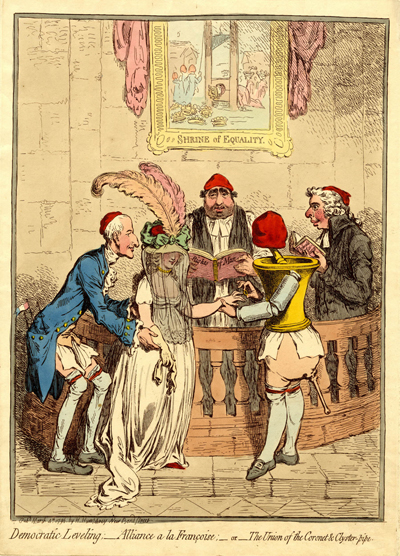Democratic Leveling. . .
This delightfully surreal print, Democratic Leveling; Alliance a la Francoise, or the Union of the Coronet & Clyster-pipe, was prompted by the elopement some time before March 2, 1796 of Lady Lucy Rachel Stanhope, the daughter of the radical Whig, Earl Stanhope, with Thomas Taylor, the family apothecary.* The actual marriage did not take place until April 26, 1796 more than a month after this print was published.

© Trustees of the British Museum
The father of the bride was well known to Gillray and his audience from his notable speech in the House of Lords in April 1794 declaring himself a sans-culotte citizen, and the resulting broadside from Gillray, The Noble Sans-Culotte (May 3rd,1794). The following two verses from the broadside provide a glimpse of his reputation.
Rank, character, distinction, fame,
And noble birth forgot,
Hear St****pe, modest Earl proclaim
Himself a Sans Culotte!
Of pomp and splendid circumstance
The vanity he teaches,
And spurns, like Citizens of France,
Both Coronet and Breeches.
In Democratic Leveling. . . Stanhope appears sans breeches with the typical bonnet rouge. From his coat pocket appears a model ship flying the French tri-color flag. As the British Museum commentary suggests, the allusion is to a 1795 print by James Sayers (who was also working for Hannah Humphrey at the time) showing Stanhope as the figurehead of a Republican gun boat sailing steadily against the tide of British public opinion.
Working in the age old tradition of caricature showing people as half human half object, Gillray portrays the groom, Thomas Taylor, as a collection of implements from his trade as an apothecary. His head and upper body are a mortar and pestle (topped, of course, by a bonnet rouge). His lower body is a clyster pipe. And his arms are medicine phials.
In keeping with its republican theme, the ceremony is presided over by the Whig leader, Charles James Fox, reading from the gospel of revolutionary documents, Thomas Paine's The Rights of Man. He is assisted, as usual, by Richard Brinsley Sheridan holding a copy of Thelwall's Lectures—the lectures that helped bring Thelwall to the bar on a charge of treason in 1794.
Behind Fox is an ironic painting/window titled "The Shrine of Equality" revealing the ultimate leveller, a guillotine, before which everyone is equal. The coronets of executed kings and nobles are strewn before it and more nobles with coronets stand in line awaiting their fate.
In actuality, in spite of all his revolutionary fervor, Stanhope was terribly upset by his daughter's marriage outside her class, and for quite some time refused a reconciliation with her. It took the intervention of his brother-in-law, William Pitt, providing an office for Taylor as controller-general of the customs to bring about some rapprochement.
* The elopement was certainly known in some circles by March 2, 1796 because by that date under the heading of "Derogatory Marriage" the Tomahawk or Censor General had run a story of a "worthy, sensible Lord" whose daughter ran off with a coachman. The man tells his son-in-law that he has no intention of making him "what nature has forbid—a gentleman." Instead he gives him horses and carriages and bids him to ply his trade. The piece concludes with "We hope Lord Stanhope will give his son-in-law a good pestle and mortar."
Sources and Reading
- Commentary from the British Museum on Democratic Leveling. . .
- "Charles Stanhope, 3rd Earl Stanhope," Wikipedia
- "John Thelwall," Wikipedia
- Thomas Wright and R.H. Evans, Historical and Descriptive Account of the Caricatures of James Gillray #146
Comments & Corrections
NOTE: Comments and/or corrections are always appreciated. To make that easier, I have included a form below that you can use. I promise never to share any of the info provided without your express permission.